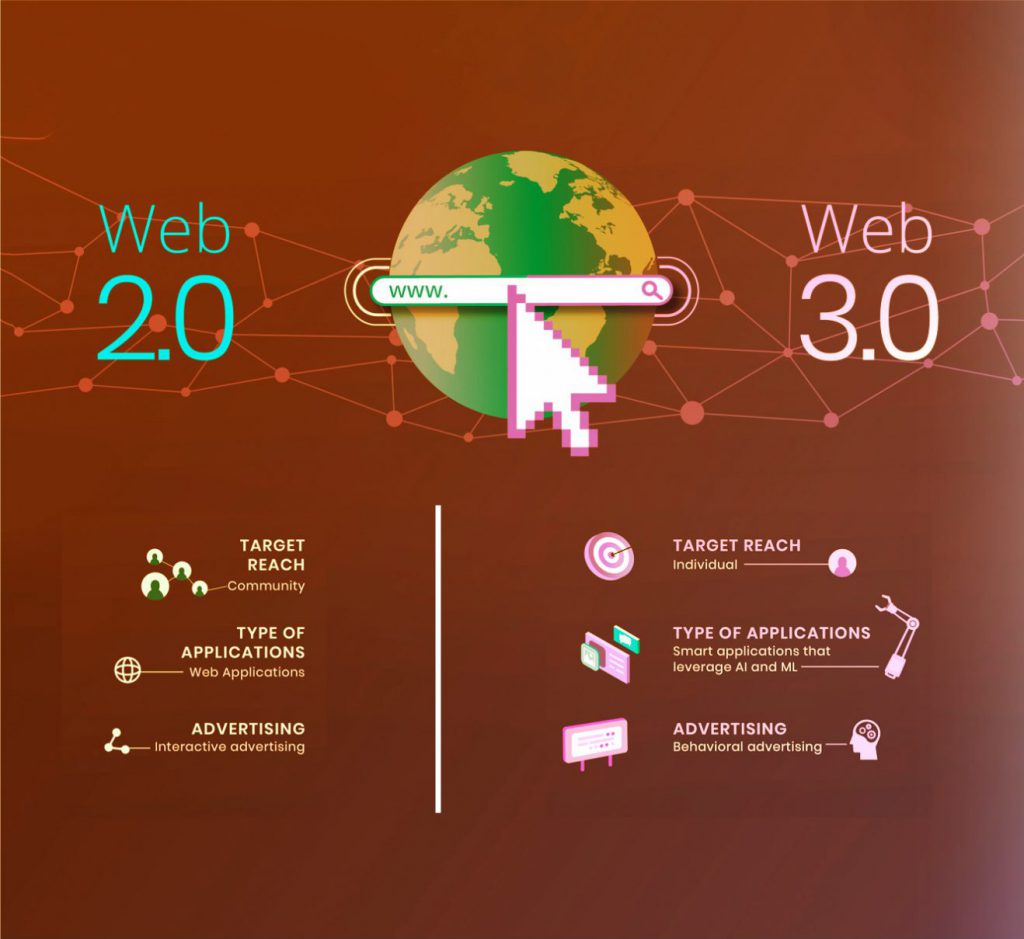The next generation of the Internet, or Web 3.0, is the next evolutionary step of the World Wide Web. It delivers a data-driven Semantic Online that uses machine-based data interpretation to present consumers with a more sophisticated and integrated web experience.
Today’s Internet is rigid, unable to adapt to the unique demands of each person who uses it. Web 3.0 claims to be more responsive and engaging than previous versions. It will reimagine the web experience with structural improvements to assure equality across all elements of the Internet by incorporating artificial intelligence and blockchain technologies.

Data is safely saved and spread across multiple devices in Web 3.0, obviating the need for data centers. Because data no longer has any central access point, such a design decreases the possibility of significant data breaches, making it more resistant to infiltration.
Web 3.0 And Its Definition
Web 3.0 is a decentralized web, powered by machine learning and artificial intelligence and uses blockchain technology for its function. The end result is a human conversation in the real world. Users have custody of their data and material, and they may sell or trade it without losing ownership, jeopardizing their privacy, or relying on third parties. Users can log onto a website without revealing their online identity under this business strategy.

The digitalization of resources via tokenization is fundamental to Web 3.0 development. Tokenization is the process of converting natural resources and rights into a digital form, or token, that can be used on a blockchain system. Cryptocurrencies are exchangeable tokens or digital assets that can be readily transferred between networks and are a business concept that democratizes money and trade. NFTs (nonfungible tokens) are data units that contain unique attributes such as characters, visual art, or collectibles that users may own and market for their advantage.
The Defining Features Of Web 3.0:
Semantic Web:
The Semantic Web is the next milestone in the development of the Internet. The Semantic Web enhances web technologies’ ability to produce, exchange, and link material through search and analysis by focusing on the definition of words rather than buzzwords or figures.
Artificial Intelligence (AI):
By integrating semantic skills with computational linguistics, computers can comprehend information on a human-like level, resulting in quicker and more relevant outcomes. As a result, they grow more innovative and better able to meet the demands of consumers.
3D Graphics:
In Web 3.0, the employment of a three-dimensional framework is common in websites and services. It may have been seen in museum guides, electronic games, eCommerce, geographical settings, and other relevant places.
Connectivity:
Thanks to semantic metadata, information linking is better than ever with Web 3.0. Consequently, the user experience advances to a new level of connection that takes benefit of all accessible data.

Ubiquity:
Instead of being limited to computers and smartphones, access to information and services from the Internet anywhere at any time using a variety of devices is possible. The Web 2.0 is already omnipresent, with the rise of Internet Of Things(IoT) devices will push it to new heights.
Blockchain:
User data is safeguarded and encrypted using blockchain technology. It stops major corporations from gaining control of or exploiting consumers’ personal information.
Decentralized:
In the decentralized system, data is stored in decentralized data networks with the help of peer-to-peer connections. Users retain control of their data and digital resources, and they may log in safely and anonymously via the Internet.
Edge Computing:
Edge computing, in which the handling of applications and content at the network edge on devices such as mobile phones, computers, appliances, sensors, and potentially smart automobiles, is at the heart of Web 3.0.
Conclusion:
You may ask your automotive helper a question while driving on Web 3.0: “I’d like to see a horror movie and eat Mexican food.” The search engine built into the vehicle assistant gives you a customized answer based on your location, recommending the closest theater that fits your request and an excellent Mexican restaurant based on social media ratings. Then it might display a 3D menu from the Mexican restaurant on the screen.
Web 3.0 is no longer a pipe dream; it has become a reality (at least in many cases). Indeed, cognitive technology, such as that provided by an expert. AI makes all of this possible and feasible. So, learning about innovative technologies from an early age, is a good idea for young minds.
 1551
1551

